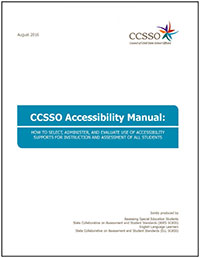 An accessibility manual was recently published by the Council of Chief State School Officers (CCSSO). It was developed in collaboration with NCEO, state partners, and the Assessing Special Education Students (ASES) State Collaborative on Assessment and Students Standards (SCASS), and the English Language Learners SCASS (ELL SCASS).
An accessibility manual was recently published by the Council of Chief State School Officers (CCSSO). It was developed in collaboration with NCEO, state partners, and the Assessing Special Education Students (ASES) State Collaborative on Assessment and Students Standards (SCASS), and the English Language Learners SCASS (ELL SCASS).
The Council of Chief State School Officers’ (CCSSO’s) Accessibility Manual: How to Select, Administer, and Evaluate Use of Accessibility Supports for Instruction and Assessment of All Students establishes guidelines for states to use for the selection, administration, and evaluation of accessibility supports for instruction and assessment of all students, including students with disabilities, English learners (ELs), ELs with disabilities, and students without an identified disability or EL status.
Accessibility supports discussed in the manual include both embedded (digitally-provided) and non-embedded (non-digitally or locally provided) universal features that are available to all students as they access instructional or assessment content, designated features that are available for those students for whom the need has been identified by an informed educator or team of educators, and accommodations that are generally available for students for whom there is documentation on an Individualized Education Program (IEP) or 504 accommodation plan. Approaches to these supports may vary depending on state or assessment consortium contexts as well as the nature of the assessments—whether content assessments, English language proficiency (ELP) assessments, or alternate assessments.
The manual can be customized by a state, and then used by teachers, administrators, and assessment staff to select, administer, and evaluate instructional and assessment accessibility supports. It includes numerous tools that can be used to assist with the decision-making process.
